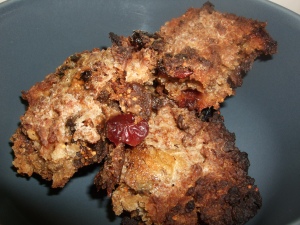
This week’s book is ‘Just Like Mother Used To Make’ by Tom Norrington-Davies, and I don’t know what it was about the full page photo of Millionaire’s Shortbread on page 71, but it was calling to me. I had to make it. It’s not something I associate in any way with my mother or my childhood – jam tarts, peppermint creams and gingerbread men, yes, sticky layers of biscuit-toffee-chocolate, no. It might be a caramel thing. Ever since I discovered salted caramel and obssessed over the Ottolenghi caramel macadamia cheesecake until finally making it at Christmas, I’ve been a little bit crazy about caramel, and I could see a thick, amber layer of it gleaming sweetly at me from between two slabs of chocolate and shortbread.
Luckily, I had the perfect excuse in the form of a work birthday which I’d been tasked with making cakes for. The person in question had told me quite specifically that she liked fruit-based cakes best, but I brushed that little detail aside. Fruit, schmuit. I was almost certain that this would probably be her second choice, if she had one.
Not everything went exactly to plan – I thought I’d make them in advance on Sunday to give me plenty of time to, you know, check they tasted alright (don’t worry, this recipe makes a lot of shortbread). This is not a quick afternoon tea treat – there are several stages of cooling involved, and if you’re me, an extra trip to the shop when you overheat the chocolate and it goes grainy and you have to buy more. Although, if you do do this, know that you can bake the overheated chocolate into brownies and it will be fine and no-one will be any the wiser (um, unless they’re reading this). Also, my caramel took much longer than the 3 minutes specified in the recipe (I might have been a bit over-generous with the condensed milk in my excitement.)
Don’t let any of this put you off – I may have had to take my first bite after dinner, several hours after the caramel craving first hit, but it was worth the wait. Oh yeah, they went down pretty well at work too.
Millionaire shortbread Fills a 20cm x 40cm tray
A couple of notes: first, I would advise cutting these into small squares. That way, you can have one and not feel too bad when you have another one later. My first wedge was a bit hefty and I almost struggled to finish it.
Secondly, the recipe asks for milk chocolate, which I thought would be a bit sickly, so I used Bourneville as a compromise. In retrospect, I can see milk chocolate working, so I think go with whatever chocolate you like best. Also, Tom felt that there was not enough chocolate. I think he’s wrong, but have duly noted his comments.
For the shortbread:
125g butter (salted is best)
50g caster sugar
175g plain flour
For the caramel:
125g butter
100g caster sugar
2 tbsp golden syrup
1/2 tin condensed milk (about 200g)
For the topping:
200g chocolate
Preheat the oven to 170c. Grease and line a 20 x 40cm baking tray with baking parchment.
Rub all of the shortbread ingredients together with your fingertips as if you were making crumble or pastry, but keep going until a dough starts to form. This might seem at first like it’s never going to happen, but it will. You’ll know you’re there when you can squeeze it into a ball and it holds together. Press it evenly into the base of the tray. Now, it may look as if it won’t cover the base of the tray, but it will honestly turn out quite thick, so just keep squidging it in. Bake it for about 20 minutes and then leave to cool – it should still be pale.
For the caramel, heat the butter and sugar in a saucepan. When the sugar has dissolved add the syrup and condensed milk. Bring the mixture to a boil, lower the heat and simmer for 3-4 minutes, stirring it constantly, until it thickens and turns a toffee colour. For me this took more like 30 minutes – just remember to keep stirring and don’t let it get too hot. It firms up a lot as it cools, so don’t worry if it seems a little runny. When it reaches the desired colour, pour it over the shortbread. Put the whole lot in the fridge to set for an hour.
Now for the chocolate. Norrington-Davies melts the chocolate with 4 tablespoons of water to make it easier to pour and so the topping is smooth and doesn’t set completely hard. Having done this, I realised that I prefer my chocolate toppings to be hard and shattery rather than soft and smooth, so I would leave out the water next time. Whichever path you take, break the chocolate into pieces and melt it either over a pan of hot water or in the microwave (carefully!) Pour it over the toffee and biscuit and smooth it out. Put it back in the fridge for at least an hour before you go at it with a knife.
It will last in the fridge for about a week.
Adapted from Tom Norrington-Davies’ ‘Just Like Mother Used To Make’.









